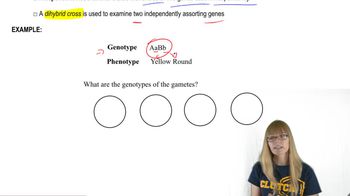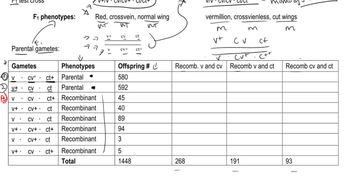Table of contents
- 1. Introduction to Genetics51m
- 2. Mendel's Laws of Inheritance3h 37m
- 3. Extensions to Mendelian Inheritance2h 41m
- 4. Genetic Mapping and Linkage2h 28m
- 5. Genetics of Bacteria and Viruses1h 21m
- 6. Chromosomal Variation1h 48m
- 7. DNA and Chromosome Structure56m
- 8. DNA Replication1h 10m
- 9. Mitosis and Meiosis1h 34m
- 10. Transcription1h 0m
- 11. Translation58m
- 12. Gene Regulation in Prokaryotes1h 19m
- 13. Gene Regulation in Eukaryotes44m
- 14. Genetic Control of Development44m
- 15. Genomes and Genomics1h 50m
- 16. Transposable Elements47m
- 17. Mutation, Repair, and Recombination1h 6m
- 18. Molecular Genetic Tools19m
- 19. Cancer Genetics29m
- 20. Quantitative Genetics1h 26m
- 21. Population Genetics50m
- 22. Evolutionary Genetics29m
4. Genetic Mapping and Linkage
Trihybrid Cross
Problem 22c
Textbook Question
An organism of the genotype AaBbCc was testcrossed to a triply recessive organism (aabbcc). The genotypes of the progeny are presented in the following table. 20 AaBbCc 20 AaBbcc 20 aabbCc 20 aabbcc 5 AabbCc 5 Aabbcc 5 aaBbCc 5 aaBbcc If these three genes were all assorting independently, how many genotypic and phenotypic classes would result in the offspring, and in what proportion, assuming simple dominance and recessiveness in each gene pair?
 Verified step by step guidance
Verified step by step guidance1
Identify the genotypes of the parent organisms: AaBbCc and aabbcc.
Determine the possible gametes produced by each parent. The AaBbCc parent can produce 2^3 = 8 different gametes (ABC, ABc, AbC, Abc, aBC, aBc, abC, abc), while the aabbcc parent can only produce one type of gamete (abc).
Since the aabbcc parent can only produce one type of gamete, the genotypes of the offspring will be determined by the gametes from the AaBbCc parent.
Calculate the number of genotypic classes: Each gene pair (A/a, B/b, C/c) can independently assort into two possible genotypes (dominant or recessive), resulting in 2^3 = 8 genotypic classes.
Calculate the number of phenotypic classes: Assuming simple dominance, each gene pair will result in one dominant phenotype if at least one dominant allele is present, leading to 2^3 = 8 phenotypic classes.
Recommended similar problem, with video answer:
 Verified Solution
Verified SolutionThis video solution was recommended by our tutors as helpful for the problem above
Video duration:
2mPlay a video:
Was this helpful?
Key Concepts
Here are the essential concepts you must grasp in order to answer the question correctly.
Independent Assortment
Independent assortment is a fundamental principle of genetics stating that alleles for different genes segregate independently of one another during gamete formation. This means that the inheritance of one trait will not affect the inheritance of another, allowing for a variety of combinations in the offspring. In the context of the question, it implies that the three genes (A, B, and C) can combine in multiple ways, leading to a diverse array of genotypes and phenotypes.
Recommended video:
Guided course

Gamete Genetics and Independent Assortment
Testcross
A testcross is a genetic cross performed to determine the genotype of an organism exhibiting a dominant phenotype. This is done by crossing it with a homozygous recessive individual. In this scenario, the organism with genotype AaBbCc is crossed with aabbcc, allowing the observation of offspring to infer the genetic makeup of the dominant parent based on the phenotypes of the progeny.
Genotypic and Phenotypic Ratios
Genotypic ratios refer to the relative frequencies of different genotypes in the offspring, while phenotypic ratios refer to the relative frequencies of observable traits. In this case, the question asks for the expected ratios based on the assumption of simple dominance and recessiveness. By applying the principles of independent assortment and the testcross results, one can calculate the expected number of each genotype and phenotype among the offspring.
Recommended video:
Guided course

Gamete Genotypes

 26:8m
26:8mWatch next
Master Trihybrid Cross with a bite sized video explanation from Kylia Goodner
Start learningRelated Videos
Related Practice


